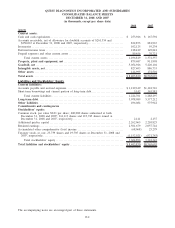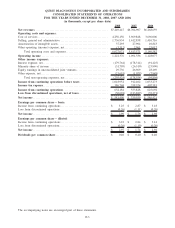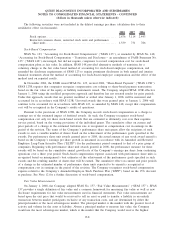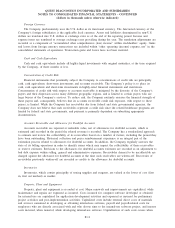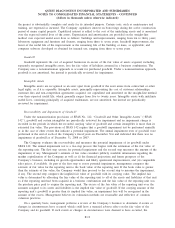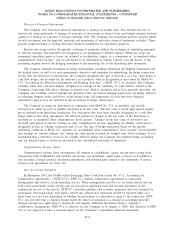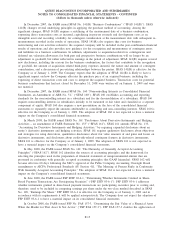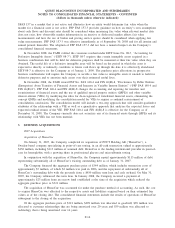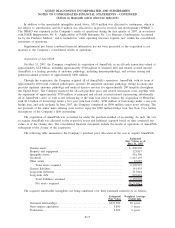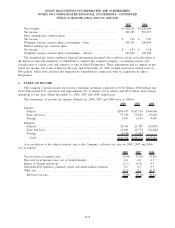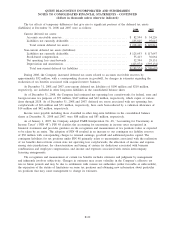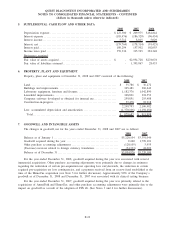Quest Diagnostics 2008 Annual Report Download - page 84
Download and view the complete annual report
Please find page 84 of the 2008 Quest Diagnostics annual report below. You can navigate through the pages in the report by either clicking on the pages listed below, or by using the keyword search tool below to find specific information within the annual report.the project is substantially complete and ready for its intended purpose. Certain costs, such as maintenance and
training, are expensed as incurred. The Company capitalizes interest on borrowings during the active construction
period of major capital projects. Capitalized interest is added to the cost of the underlying assets and is amortized
over the expected useful lives of the assets. Depreciation and amortization are provided on the straight-line
method over expected useful asset lives as follows: buildings and improvements, ranging from ten to thirty years;
laboratory equipment and furniture and fixtures, ranging from three to seven years; leasehold improvements, the
lesser of the useful life of the improvement or the remaining life of the building or lease, as applicable; and
computer software developed or obtained for internal use, ranging from three to seven years.
Goodwill
Goodwill represents the cost of acquired businesses in excess of the fair value of assets acquired, including
separately recognized intangible assets, less the fair value of liabilities assumed in a business combination. The
Company uses a nonamortization approach to account for purchased goodwill. Under a nonamortization approach,
goodwill is not amortized, but instead is periodically reviewed for impairment.
Intangible Assets
Intangible assets are recognized as an asset apart from goodwill if the asset arises from contractual or other
legal rights, or if it is separable. Intangible assets, principally representing the cost of customer relationships,
customer lists and non-competition agreements acquired, are capitalized and amortized on the straight-line method
over their expected useful life, which generally ranges from five to twenty years. Intangible assets with indefinite
useful lives, consisting principally of acquired tradenames, are not amortized, but instead are periodically
reviewed for impairment.
Recoverability and Impairment of Goodwill
Under the nonamortization provisions of SFAS No. 142, “Goodwill and Other Intangible Assets” (“SFAS
142”), goodwill and certain intangibles are periodically reviewed for impairment and an impairment charge is
recorded in the periods in which the recorded carrying value of goodwill and certain intangibles is more than its
estimated fair value. The provisions of SFAS 142 require that a goodwill impairment test be performed annually
or in the case of other events that indicate a potential impairment. The annual impairment tests of goodwill were
performed at the end of each of the Company’s fiscal years on December 31st and indicated that there was no
impairment of goodwill as of December 31, 2008 or 2007.
The Company evaluates the recoverability and measures the potential impairment of its goodwill under
SFAS 142. The annual impairment test is a two-step process that begins with the estimation of the fair value of
the reporting unit. The first step screens for potential impairment and the second step measures the amount of the
impairment, if any. Management’s estimate of fair value considers publicly available information regarding the
market capitalization of the Company as well as (i) the financial projections and future prospects of the
Company’s business, including its growth opportunities and likely operational improvements, and (ii) comparable
sales prices, if available. As part of the first step to assess potential impairment, management compares the
estimate of fair value for the reporting unit to the book value of the reporting unit. If the book value is greater
than the estimate of fair value, the Company would then proceed to the second step to measure the impairment,
if any. The second step compares the implied fair value of goodwill with its carrying value. The implied fair
value is determined by allocating the fair value of the reporting unit to all of the assets and liabilities of that unit
as if the reporting unit had been acquired in a business combination and the fair value of the reporting unit was
the purchase price paid to acquire the reporting unit. The excess of the fair value of the reporting unit over the
amounts assigned to its assets and liabilities is the implied fair value of goodwill. If the carrying amount of the
reporting unit’s goodwill is greater than its implied fair value, an impairment loss will be recognized in the
amount of the excess. Management believes its estimation methods are reasonable and reflective of common
valuation practices.
On a quarterly basis, management performs a review of the Company’s business to determine if events or
changes in circumstances have occurred which could have a material adverse effect on the fair value of the
Company and its goodwill. If such events or changes in circumstances were deemed to have occurred, the
F-12
QUEST DIAGNOSTICS INCORPORATED AND SUBSIDIARIES
NOTES TO CONSOLIDATED FINANCIAL STATEMENTS - CONTINUED
(dollars in thousands unless otherwise indicated)


